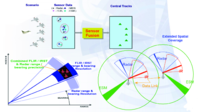
Photo from wikipedia
Optical coherence tomography (OCT) has become the gold standard for ophthalmic diagnostic imaging. However, clinical OCT image-quality is highly variable and limited visualization can introduce errors in the quantitative analysis… Click to show full abstract
Optical coherence tomography (OCT) has become the gold standard for ophthalmic diagnostic imaging. However, clinical OCT image-quality is highly variable and limited visualization can introduce errors in the quantitative analysis of anatomic and pathologic features-of-interest. Frame-averaging is a standard method for improving image-quality, however, frame-averaging in the presence of bulk-motion can degrade lateral resolution and prolongs total acquisition time. We recently introduced a method called self-fusion, which reduces speckle noise and enhances OCT signal-to-noise ratio (SNR) by using similarity between from adjacent frames and is more robust to motion-artifacts than frame-averaging. However, since self-fusion is based on deformable registration, it is computationally expensive. In this study a convolutional neural network was implemented to offset the computational overhead of self-fusion and perform OCT denoising in real-time. The self-fusion network was pretrained to fuse 3 frames to achieve near video-rate frame-rates. Our results showed a clear gain in peak SNR in the self-fused images over both the raw and frame-averaged OCT B-scans. This approach delivers a fast and robust OCT denoising alternative to frame-averaging without the need for repeated image acquisition. Real-time self-fusion image enhancement will enable improved localization of OCT field-of-view relative to features-of-interest and improved sensitivity for anatomic features of disease.
Journal Title: Biomedical optics express
Year Published: 2022
Link to full text (if available)
Share on Social Media: Sign Up to like & get
recommendations!